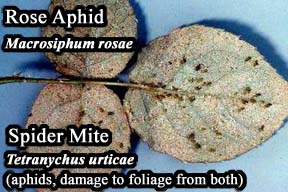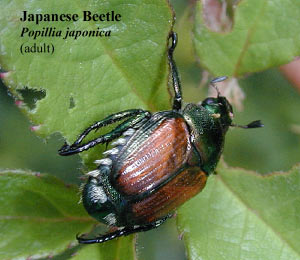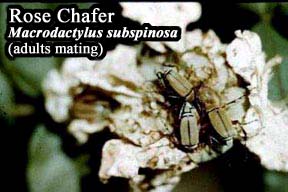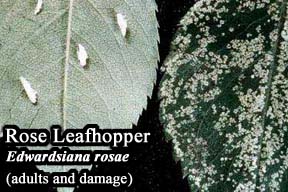Rose (Rosa)
Plant Health Problems
Diseases caused by Fungi:
Black spot, Diplocarpon rosae.
Black spot is a common and persistent disease of roses. Foliar symptoms appear as black spots with fringed margins. These symptoms are often accompanied by extensive yellowing of leaflets and leaf drop. Black lesions can develop on canes and are a means of overwintering for the fungus. These may also serve as sources of infection for the following spring. Cultivars vary in susceptibility.
Black spot may be reduced by removing infected leaves as soon as they appear in the spring and by removal of all fallen leaves from around the plant, particularly in the fall. Diseased canes should also be pruned out and removed. Resistant varieties are also available. Although 100 percent control is almost impossible, control can be enhanced with the use of fungicides applied as soon as symptoms appear. Among the compounds registered for use in Connecticut are copper hydroxide, copper sulphate pentahydrate, thiophanate-methyl, triforine, chlorothalonil, and mancozeb. Consult the label for dosage rates and safety precautions. For more information, see the factsheet on Common Diseases of Rose.
Powdery mildew, Sphaerotheca pannosa var. rosae.
Powdery mildew covers the leaves, petioles, stems, and calyx of rose with white powdery mycelium. The plant may take on a gray to white overall appearance in severe cases. Young leaves curl upward and may be deformed, and young shoots may be killed back. Infected buds often don't open, and on ramblers infected flowers look prematurely wilted and discolored.
Raking and removing fallen leaves in autumn can reduce the overwintering inoculum. Resistant varieties are also available. Control can also be achieved with the use of fungicides as soon as symptoms occur. Among the compounds registered for use in Connecticut are sulfur, potassium bicarbonate, thiophanate-methyl, copper sulphate pentahydrate, and triforine. Consult the label for dosage rates and safety precautions. For more information, see the factsheet on Common Diseases of Rose.
Botrytis blight, Botrytis cinerea.
Buds of certain varieties turn brown and decay before opening. The gray mold of the fungus may often be found inside or over the outside of the bud. The bud may appear to be covered in gray fuzz. Infection after the flowers have opened results in small tan spots on the petals, with petal drop in severe cases.
Some varieties are very susceptible to the ravages of Botrytis, and the only protection against it appears to be good aeration around plants. Control can also be achieved with the use of fungicides as soon as symptoms occur. Among the compounds registered for use in Connecticut are potassium bicarbonate, iprodione, chlorothalonil, copper sulphate pentahydrate, thiophanate-methyl, and mancozeb. Consult the label for dosage rates and safety precautions. For more information, see the factsheet on Common Diseases of Rose.
Anthracnose, Sphaceloma rosarum.
The dark brown to black spots scattered on leaves or calyx lobes eventually develop a whitish center. Tissue may fall out leaving margins ragged. Infection may turn leaves yellow, red yellow, or reddish brown. Smaller lesions occur on stems, thorns, hips, and flower stalks and are usually raised or depressed in the center.
Removal of affected parts is helpful. Fungicide applications as for control of black spot may control this fungus.
Downy mildew, Peronospora sparsa.
Symptoms of downy mildew occur on leaves, stems, peduncles, calyxes, and petals. Leaves develop purplish red to dark brown irregular spots; leaf drop may be severe. Downy mildew differs from powdery mildew in that the greyish spores of downy mildew are produced only on the lower leaf surfaces; powdery mildew is found on both leaf surfaces. Downy mildew also causes severe defoliation, while powdery mildew kills tissue only when infection is severe over an extended period of time.
Control can be achieved with the use of fungicides applied as soon as symptoms appear. Among the compounds registered for use in Connecticut is mancozeb. Consult the label for dosage rates, safety precautions, and indoor use. For more information, see the factsheet on Common Diseases of Rose.
Rust, Phragmidium sp.
Orange-brown spores are extruded from pustules on the lower side of leaves. Later these turn black with winter spores. Young stems may be split and distorted with this stage.
Pruning infected wood and raking and removing fallen leaves is helpful. Chemical control is usually not necessary. For more information, see the factsheet on Common Diseases of Rose.
Cankers, various fungi.
Symptoms appear as sunken, often discolored areas on the canes. When the cankers girdle the canes, dieback can occur.
Differentiation among the canker-producing fungi is unimportant as control is the same for all. Control is best achieved by pruning affected canes back to healthy wood in spring. It is also helpful to promote plant vigor by fertilizing and watering during periods of drought. For more information, see the factsheet on Common Diseases of Rose.
Diseases caused by Bacteria:
Crown gall, Agrobacterium tumefaciens.
Irregular or spherical galls appear on roots, crown, or canes. The causal bacteria can be kept out by avoiding wounds.
Removal and destruction of infected plants, planting only disease-free stock, and planting in uninfested soil are essential. For more information, see the factsheet on Common Diseases of Rose.
Diseases caused by Viruses:
Mosaic, virus.
The typical symptom of this disease is a chlorotic discoloration feathering out from the veins, together with a distortion of the leaflet. Yellow watermarks, vein clearing, or dull yellow blotching may also be virus expression. Symptoms vary sometimes showing only when grown indoors and may appear only on one or several leaves. Since mosaic is transmitted only by grafting, no danger of spreading it in the garden need be considered. Mosaic symptoms may be confused with "crinkle," an unexplained physiological trouble. There are also yellow mosaics in which symptoms are more conspicuous. Mosaic-infested plants commonly lag in growth and produce few if any flowers. For more information, see the factsheet on Common Diseases of Rose.
Streak, virus.
Brownish rings and veinbanding or a greenish senescence pattern similar to brown patterns on leaves or canes mark this trouble. Necrotic lesions may appear around the bud and on canes above the bud.
Transmission and control are the same as for Mosaics.
Insect Problems Aphids.
Aphids.
The rose aphid, Macrosiphum rosae and the potato aphid, M. solanifolii attack rose. In the early summer, it is a common sight to see the new shoots and leaves thickly infested. These aphids may be controlled by spraying thoroughly with ultrafine horticultural oil, malathion or insecticidal soap, which are some of the compounds registered for control of this pest in Connecticut. Imidacloprid, applied in the spring as a soil drench will provide season-long, systemic control and has the additional benefit of killing adult Japanese beetles. Consult the label for dosage rates and safety precautions.
Flower thrips, Frankliniella tritici.
The thrips attacks the flower buds, causing discoloration of the petals. This usually results in deformity or failure to mature. The extremely active adult thrips is very small, slender, brownish yellow in color, with feathery wings. The young are lemon colored. There are two or more generations during the summer, occurring at about two week intervals during a hot, dry season. Among the compounds registered for control of this pest in Connecticut are acephate, insecticidal soap, spinosad, or ultrafine horticultural oil. All can be applied as foliar sprays when insects are present. Multiple applications may be necessary. Consult the label for dosage rates and safety precautions.
Fuller rose beetle, Asynonychus godmani.
Roses and many other plants in greenhouses as well as outdoors are sometimes injured by Fuller rose beetle, which feeds on the leaves at night and rests in the leaves or in some protected place during the day. This is a brown weevil marked with patches of gray scales on fused wing covers. Only females exist. It varies in length from 1/4" to 3/8" (7-9 mm). The eggs are laid under the edges of bark near the ground or directly on the ground and can be found throughout the season. The white legless grubs live in the soil and chew upon the roots of various plants. At maturity, they measure about 1/2" (10-12 mm). This weevil overwinters as a pupa near the soil surface or as an adult in a protected spot. Adults do the most damage. Control treatments are rarely needed. When the infestation is light, handpicking the insects is a possibility.
Imported longhorned weevil, Calomycterus setarius.
The grayish adults are about 1/8" long. They emerge from late June through July and early August. Eggs are laid in the soil, and larvae are present from mid-summer until June of the following year. They feed on the small roots of host plants but more often on those of legumes or on organic matter. Both wild and cultivated plants are attacked. Usually, the adults feed on the upper surface at the edge of the leaves and on flowers in sunlight or shade. Host plants include annuals, perennials, shrubs, deciduous trees, and evergreens. Drenching insect pathogenic nematodes around the roots may control larvae.
 Japanese beetle, Popillia japonica.
Japanese beetle, Popillia japonica.
This beetle in the adult stage feeds upon a great variety of trees and plants, and rose is one of its favorites. The beetle is about half an inch in length, bright, shining green, with wing covers of a copper color. Two white spots on the tip of the abdomen show beyond the ends of the wing covers, and there are five white spots formed by patches of white hairs on each side of the abdomen. The beetles begin to emerge the latter part of June; their greatest abundance is usually about the middle of July, but in certain seasons, particularly after drought periods, they may disappear altogether. The eggs are laid in July in the soil, and the grubs feed on grass roots near the surface, going downward to a depth of about a foot to overwinter. Late in April, they return to the surface, feed for a time, then enter the prepupal stage, and pupate in late May or early June. From 2 to 4 weeks later, the adults emerge. There is one generation each year. Feeding on the foliage of roses can be prevented by using sprays of acephate, azadirachtin, carbaryl or malathion, which are among the products registered for use against this pest in Connecticut. Imidacloprid, applied early in the season as a soil drench, will provide season-long systemic control. Consult the label for dosage rates and safety precautions. With the exception of imidacloprid, it is difficult to protect the blossoms. Treatment of lawn areas should reduce the numbers of beetles. See Lawns, oriental beetle.
 Rose chafer, Macrodactylus subspinosus.
Rose chafer, Macrodactylus subspinosus.
When very abundant, this insect injures roses and many other shrubs and trees when adult beetles skeletonize the leaves. They also cause injury to the flowers, particularly white flowers, by feeding upon the petals and soiling them with excrement. Rose chafers breed most abundantly in sandy waste land but sometimes occur in lawns; they appear each year about June 10 to 12, and feed for about a month, though some of the beetles are present for 6 weeks. The females each lay from 24 to 36 eggs singly in the ground a few inches beneath the surface. They soon hatch and the young grubs feed upon the roots of grass and other plants, becoming full grown by late autumn when they go into the ground several inches to overwinter. The next April or May, they come near the surface and transform to pupae in earthen cells, and from 2 to 4 weeks later the beetles emerge. The adult beetle is yellowish grayish brown or clay colored and is a little over 1/3" (10-12 mm) long, with long sprawling legs. The larva is a white grub about 3/4" long when full grown. For control, see Japanese beetle above.
Rose curculio, Merhynchites bicolor.
This weevil has the habit of eating holes in the buds of rugosa and other kinds of roses. It is about 1/4" (6 mm) long and is red with a black snout. Eggs are laid in the flower buds where the white legless larvae feed on the reproductive parts of the flower. When fully grown the larvae fall to the ground and enter the soil to overwinter. In the spring, larvae pupate and adults emerge several weeks later. There is only one generation per year. Handpicking is the usual method of control, but in severe infestations, see treatment procedures for Japanese beetle above.
Rose galls.
These insects cause swellings or galls on roses. One of the galls is moss-like in appearance. Another is more corky in texture and occurs on the roots of infested plants. They do not kill the plants, as only the root is attacked. Control may be expected when the galls are removed and disposed of as soon as discovered.
 Rose leafhopper, Edwardsiana rosae.
Rose leafhopper, Edwardsiana rosae.
The adults and nymphs are usually on the undersides of the leaves. On the upper side, there is usually a white peppered effect that indicates the presence of the leafhoppers. These insects suck the sap and destroy chlorophyll. Severely injured leaves drop prematurely. There are two generations each season, and the insect overwinters as eggs in rose, blackberry or raspberry canes. Leafhoppers can be controlled by spraying the undersides of the leaves as needed with insecticidal soap, malathion or carbaryl, which are among the compounds registered for control of this pest in Connecticut. Imidacloprid applied to the soil as a systemic can provide season-long control. Consult the label for dosage rates and safety precautions.
Rose leaf beetle, Nodonota puncticollis.
The small oval, metallic greenish beetles appear in late spring and bore into the flower buds and partially open flowers. When the beetles are abundant, they also eat shot-holes in flowers at all stages of development. The larvae may live in the soil and feed on the roots of plants. Control is difficult. Handpicking beetles or jarring them into a container of water covered by a film of oil will help reduce the population. Beetles feeding within the buds cannot be effectively controlled. Among the compounds registered for control of this pest in Connecticut are pyrethrum or azadirachtin used as a spray to contact the beetles or imidacloprid applied as a soil drench early in the season to provide systemic control. Consult the label for dosage rates and safety precautions.
Rose leafrollers. Archips argyrospila, A. rosanus and Pandemis limitata.
Several species of leafrollers injure roses. All are the larvae of small moths belonging to the family Tortricidae. For A. rosanus, moths lay egg masses in late June or early July on branches. Eggs pass the winter and hatch around the second week of May. Larvae will feed on new or older foliage of terminal shoots. Spraying with Bacillus thuringiensis var. kurstaki or spinosad when caterpillars are small and reachable or acephate, which has systemic activity, has given satisfactory control. Both are among the compounds registered for control of this pest in Connecticut. Repeated treatments may be required if the infestation is heavy. Consult the label for dosage rates and safety precautions.
Rose midge, Dasineura rhodophaga.
This is a serious pest of roses in the greenhouse and is known to injure outdoor roses also. The tiny fly, resembling a miniature mosquito, does not feed, but lays yellow eggs on the tender growth near the flower or leaf buds. These hatch in 2 days, and the young larvae feed at the base of flower buds or leaf stems, causing them to become distorted and later to turn brown and die. Often there are 20 to 30 white maggots in an infested bud. The creamy white maggots mature to 1/10" (1.8 mm) in about a week, then drop to the ground to pupate in loose soil within a flimsy silken cocoon. Adults emerge about a week later. In greenhouses and outdoors, about 2 weeks are required for the life cycle. Many generations occur each year. The chief injury occurs between May and November and the flies are seldom seen during the winter. Control consists in lightly cultivating the soil in greenhouses or gardens to destroy cocoons. The new growth may be inspected frequently for signs of infestation. If needed, spraying with malathion or spinosad should control the midges before eggs are laid. Both products are among the compounds registered for control of this pest in Connecticut. Consult the label for dosage rates and safety precautions.
Rose sawflies.
The roseslug, Endelomyia aethiops; the bristly rose slug, Cladius difformis; and the curled rose sawfly, Allantus cinctus, in their larval stage all feed upon the leaves of rose. They first skeletonize the leaves and later, as their mouthparts enlarge, eat holes or notches in the margins. The roseslug has one generation per year and the others two or more generations. The female roseslug sawfly slits the leaf open, creating a pocket between the epidermal layers in which to lay an egg. Larvae feed on the upper leaf surface leaving the veins and lower epidermis. At maturity, the 1/2" long(13 mm), yellow-green caterpillar falls to the ground, burrows in and creates an overwintering cell. The bristly roseslug larva grows to 2/3" (16 mm) in length, has bristle-like hairs over its pale green body, and feeds on the underside of leaves. There may be five to six generations per year. The curled rose sawfly larva is pale green with white spots with the lower or ventral half being creamy white. When at rest, it curls up, hence the name. It matures at 3/4" and along with devouring foliage, bores into pruned twigs. Of the three, the curled rose sawfly is the most damaging. It pupates in the center portion of twigs, predisposing them to fungal infections. Slugs can be washed from the plants by a strong jet of water. If needed, from the end of May through mid-June spray both upper and lower leaf surfaces with acephate, spinosad or carbaryl, making sure to contact the slugs. Imidacloprid can be applied as a soil drench early in the season for systemic, season-long control. All these products are among the compounds registered for control of this pest in Connecticut. Consult the label for dosage rates and safety precautions.
Rose scale, Aulacaspis rosae.
The female scale is nearly circular, flat, white, and about 1/12" in diameter. The males are much smaller and are narrow and elongate. These insects suck the sap from the plant and are often numerous on the stems of rose and blackberry in sheltered situations. There are probably three complete generations each year and all stages may be found under the shells during the winter. It is best to cut out and burn the old and badly infested stems. A dormant spray of oil early in the spring will suffocate the scales. Two or three sprays directed to control crawlers can be applied at 10 day intervals, starting late in April. Appropriate materials are insecticidal soap, ultrafine oil or malathion, all of which are registered for control of this pest in Connecticut. Consult the label for dosage rates and safety precautions.
Rose stem girdler, Agrilus aurichalceus.
The grub of this beetle tunnels in the twigs of rose and causes swellings or galls, especially in Rosa rugosa and R. hugonis. The twigs often break off at this point, or they die beyond the gall but do not break. The beetles appear in June and July. The larvae make spiral tunnels just under the bark, and two years are thought to be required for larval development. The beetle is from 1/4" to 1/3" long (6-8 mm), and metallic or copper green in color. One remedy is to clip off and dispose of the infested twigs in winter or spring before the beetles emerge. Spraying with permethrin or malathion, which are among the compounds registered for control of this pest in Connecticut, during June and July will control adults before eggs are laid. Consult the label for dosage rates and safety precautions.
Twospotted spider mite, Tetranychus urticae.
This serious pest infests the undersides of the leaves, which become light yellow in color, and the plants have a generally unhealthy appearance. Sometimes the mites form webs, which more or less enclose the upper as well the lower leaf surface. Among the compounds registered for control of this pest in Connecticut are insecticidal soap and ultrafine horticultural oil. Spraying with insecticidal soap will give sufficient control if applied at least twice at 7-10 day intervals. The predatory mite, Neoseiulus fallacis, is most commonly found feeding where there are mite infestations. A single application of ultrafine horticultural oil (1/2 - 1% dilution) can be effective if predatory mites are present. Special care should be taken with soap or oil to obtain thorough spray coverage, because they only work on contact. Materials appropriate for commercial growers include hexythiazox and abamectin (a restricted use product). Consult the label for dosage rates and safety precautions. Avoid applying carbaryl or pyrethroids, which tend to be much more toxic to the predators than to the pest spider mites.

